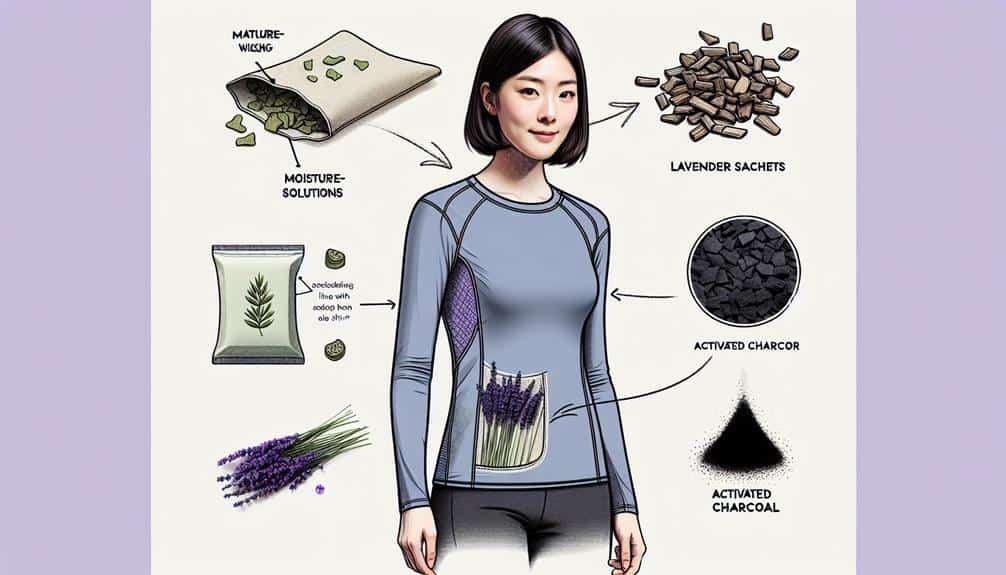Maximize the effectiveness of your moisture-wicking shirts for odor-free wear. Choose fabrics like polyester, nylon, or merino wool with anti-microbial properties. Wash with detergents designed to combat odors effectively, avoiding fabric softeners. Air dry in well-ventilated areas to maintain fabric quality. Use odor-neutralizing sprays on moisture-prone areas for scent control. Store in well-ventilated spaces to prevent bacteria growth. These suggestions guarantee your shirts stay fresh and odor-free during use.
Key Points
- Choose fabrics like polyester, nylon, or merino wool with anti-microbial finishes.
- Wash with odor-fighting detergents containing special enzymes.
- Air dry shirts in well-ventilated areas to preserve fabric care.
- Use odor-neutralizing sprays on moisture-prone areas.
- Store shirts in breathable spaces to prevent bacterial growth.
Choose Odor-Resistant Fabrics
When selecting moisture-wicking shirts for odor control, opt for fabrics treated with anti-microbial properties to inhibit bacterial growth. Fabric technology plays an important role in preventing odors from developing in your shirts. Fabrics like polyester, nylon, or merino wool are excellent choices due to their moisture-wicking properties. These fabrics draw sweat away from your body, keeping you dry and comfortable during physical activities.
Additionally, fabrics treated with anti-microbial finishes help in scent control by preventing the growth of odor-causing bacteria.
To guarantee maximum odor resistance, look for shirts that specifically mention anti-microbial or odor-resistant properties in their descriptions. These features indicate that the fabric has been treated to combat bacteria and unwanted smells. When perspiration interacts with bacteria on the skin's surface, it produces body odor. By choosing fabrics designed to inhibit bacterial growth, you can effectively manage scent control and keep your moisture-wicking shirts smelling fresh even during intense workouts.
Wash With Odor-Fighting Detergent
To effectively maintain the odor-resistant properties of your moisture-wicking shirts, make sure to launder them using detergent specifically formulated to combat odors. Essential detergents may not effectively remove the sweat and bacteria that can cause odors to linger in your moisture-wicking garments. Odor-fighting detergents are designed with special enzymes and ingredients that target and break down the compounds responsible for unpleasant smells, ensuring your shirts stay fresh and clean.
When washing your moisture-wicking shirts, it's vital to avoid using fabric softeners as they can leave residue on the fabric, reducing its moisture-wicking capabilities. Fabric softeners can also create a barrier that traps odors, counteracting the efforts of the odor-fighting detergent. Instead, opt for natural odor remedies like adding a cup of white vinegar to the rinse cycle, which helps eliminate bacteria and odors without affecting the fabric's performance.
Air Dry After Each Use
For optimal maintenance of your moisture-wicking shirts, make sure they're air-dried after each use to preserve their performance and longevity. To sustain the fabric care of moisture-wicking shirts, it's crucial to hang dry them properly. After wearing your moisture-wicking shirt, avoid throwing it in the dryer as the high heat can damage the fabric and reduce its moisture-wicking capabilities over time. Hang drying allows the shirt to air out thoroughly, preventing any moisture from being trapped and potentially leading to odor buildup.
When air-drying your moisture-wicking shirts, be mindful of where you hang them. Choose a well-ventilated area with good airflow to ensure the shirt dries completely. Additionally, avoid direct sunlight as prolonged exposure can cause colors to fade and the fabric to deteriorate. Properly caring for your moisture-wicking shirts by air-drying them after each use won't only help maintain their performance but also extend their lifespan, ultimately saving you money in the long run.
Use Odor-Neutralizing Sprays
Consider utilizing odor-neutralizing sprays to maintain the freshness of your moisture-wicking shirts, ensuring they remain free from unwanted smells. When selecting a spray, opt for scent-free solutions to avoid conflicting fragrances. These sprays work by targeting the bacteria that cause odors, rather than just masking them. To effectively use an odor-neutralizing spray, spritz it lightly on the areas of the shirt that tend to retain the most moisture and odor, such as the underarms and neckline. Allow the spray to dry completely before wearing the garment to prevent any dampness.
Scent-free solutions are ideal for those with sensitivities to perfumes and dyes, providing a gentle yet effective way to refresh your moisture-wicking shirts. By incorporating odor-neutralizing sprays into your garment care routine, you can extend the freshness of your activewear between washes. Remember to follow the instructions on the spray bottle for the best results. Regular use of these sprays can help you maintain odor-free moisture-wicking shirts, keeping you comfortable and confident during your activities.
Store in a Well-Ventilated Area
To maintain the freshness and effectiveness of your moisture-wicking shirts, make sure they're stored in a well-ventilated area after each use. Proper storage is essential for preventing the buildup of odor-causing bacteria and maintaining the fabric's moisture-wicking properties. When moisture-wicking shirts are stored in a poorly ventilated space, such as a closed gym bag or a damp locker, moisture can get trapped, creating an environment conducive to bacterial growth and unpleasant odors.
Air circulation plays an important role in keeping moisture-wicking shirts odor-free. Hanging your shirts on a clothesline or using a breathable mesh bag allows air to flow around the fabric, helping to dry out any moisture and prevent the development of odors. Additionally, storing your shirts in a well-ventilated area helps to reduce humidity levels, further inhibiting the growth of odor-causing bacteria.
Frequently Asked Questions
Can Moisture-Wicking Shirts Cause Skin Irritation or Allergic Reactions?
Moisture-wicking shirts can potentially cause skin irritation or allergic reactions due to fabric allergies and skin sensitivity. It is essential to choose shirts made from hypoallergenic materials and to wash them with gentle, fragrance-free detergents.
How Do I Know if a Moisture-Wicking Shirt Is Safe to Use for Sensitive Skin?
To discern if a moisture-wicking shirt suits sensitive skin, analyze fabric sensitivity by checking material composition for potential allergens. Prioritize skin care by opting for hypoallergenic blends to mitigate reactions.
Are There Any Specific Detergents or Sprays to Avoid When Washing Odor-Free Moisture-Wicking Shirts?
When washing odor-free moisture-wicking shirts, avoid using fabric softeners, scented detergents, and antiperspirants. These products can leave residues that hinder the fabric's moisture-wicking properties and cause odors. Stick to gentle, unscented detergents for best results.
Can Odor-Neutralizing Sprays Affect the Breathability or Wicking Capabilities of the Fabric?
When it comes to fabric care and performance, using odor-neutralizing sprays can indeed impact breathability. These sprays may leave residues that hinder the fabric's wicking capabilities, affecting its overall functionality and disrupting its ability to keep you dry and comfortable.
How Often Should I Replace My Odor-Free Moisture-Wicking Shirts to Maintain Their Effectiveness?
To maintain the effectiveness of your odor-free moisture-wicking shirts, replace them every 6-12 months depending on frequency of use. Proper care, such as washing with mild detergent and air drying, will extend their longevity and performance.



